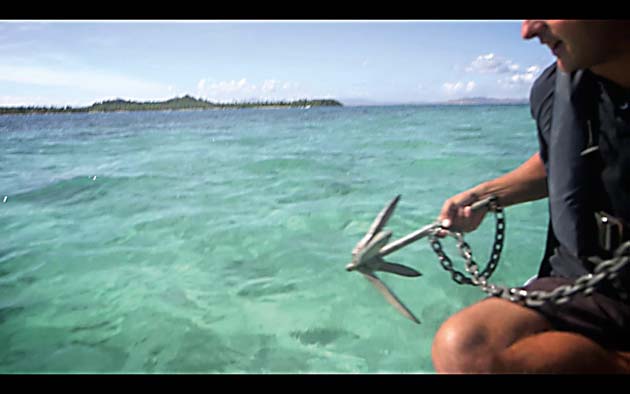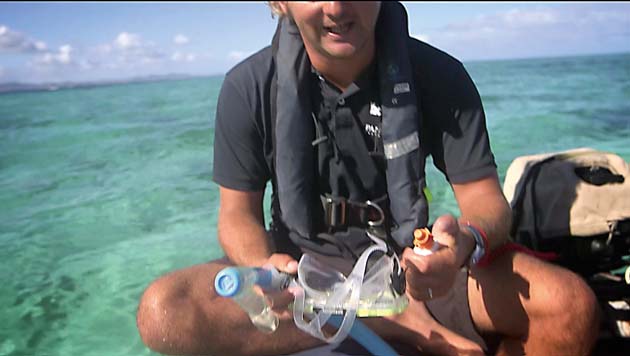It’s one of the great pleasures of cruising to explore the element below you. Dan Bower considers the practicalities of going underwater either diving or snorkelling
 When cruising in the tropics – or indeed sailing round the world – the time spent actually sailing is surprisingly insignificant and, apart from the ongoing task of yacht maintenance, provisioning and just existing, the rest of your time is spent exploring and adventuring.
When cruising in the tropics – or indeed sailing round the world – the time spent actually sailing is surprisingly insignificant and, apart from the ongoing task of yacht maintenance, provisioning and just existing, the rest of your time is spent exploring and adventuring.
On Skyelark we like to explore the islands and get a feel for life on shore, so our harbour time is usually spent hiking into the mountains, cycling the coast paths or taking tours, hiring cars and frequenting restaurants, yacht clubs and bars. But the one thing we do nearly every day at anchor is to head off for a snorkel.
When sailing westabout on the ‘Coconut Run’ – through the Panama and across the Pacific – after leaving the Caribbean the underwater seascape and wildlife just get better and better, and even out there day after day we come back saying perhaps that was the best we have seen yet.
Hammerhead sharks and eagle rays in the Galapagos, amazing pass drifts in Ahe, sharks in Rangiroa, stingrays, mantas and turtles in the Society Islands and crystal clear coral gardens and aquaria in the lagoons behind the fringeing coral reefs are just some of the highlights.
These are not just far-off sightings, but in many cases the wildlife is so abundant that it comes in countless quantities, and you can just lie there and marvel at what is passing you by, taking it all in and committing it to memory as the underwater photos and videos just don’t do it justice.
To dive or to snorkel?
On many of the reefs and passes the snorkelling is as good as the diving and has the advantage that it requires little planning or equipment and is the kind of activity you can do on a whim for an hour or so whenever you choose.
Diving, however, shouldn’t be discounted as the greater depth does give you access to bigger and more plentiful fish and mammals, and opens up possibilities and sites further offshore. The South Pacific, in particular, is considered to host many of the best dive spots in the world.
Don’t miss
♦ Reef dives – Reefs are plentiful around many of the islands, and are usually accessible to both snorkellers and divers at different depths.
Expect to see varying levels and types of coral, small tropical reef fish and occasional bigger reef predators such as barracuda, grouper and snappers. If you’re lucky, you might also see sharks or rays.
♦ Passes – Some islands have narrow gaps in the reefs, which can make for excellent snorkelling, particularly in the Pacific atolls. When there are only a small number of passes, the incoming tidal currents can create fantastic drifts.
A drift dive is where you start up-current and just drift along, playing the astronaut. In some of these passes you can easily be travelling at three or four knots, which doesn’t sound much, but the sensation of flying through the ocean seeing wonderful reefs and fish on the way is amazing.
Typically, you also see bigger fish, sharks and perhaps dolphins playing in the pass as you’re on the boundary between ocean and lagoon. You should always dive the passes at slack water or on an incoming current, so that you end up in the safety of the lagoon, and the water quality is that much clearer.
The outgoing currents can be very strong and can create standing waves so a bit of planning is required.
Underwater etiquette
Enjoy the activity responsibly! Coral is a very fragile ecosystem, easily damaged and susceptible to human influence.
The further you go from civilisation, the better condition it is in, which is why you’re there, so please protect it. Some well-dived Caribbean sites are almost destroyed – although beautiful fish swim around, the coral is largely dead, and diving/snorkelling is partly responsible.
Firstly, you should never touch coral, either by hand or by placing your fins on the ground to stand up and look around. When swimming avoid kicking up sediment with your fins – this can starve the coral – and obviously don’t take anything or leave anything behind.
Some tourist operations feed the marine life. This should not be encouraged or copied as it upsets Nature’s rhythms and routines – it is also perhaps not a good idea for big fish (sharks) to associate divers with food!
Dive equipment
Some boats opt to carry their own dive gear, including tanks and compressors, and if you are an accomplished and confident diver this may be a good option. At the very least a tank and BCD (buoyancy compensating device) can be useful for underwater maintenance or clearing a fouled anchor.
It sounds like the dream, but the reality of diving from your boat is often not that simple. You should never dive on your own, so you need a buddy in the water and to see anything more than you can with a snorkel you need a dinghy driver as well. In remote areas you need a contact with your mothership, or a second crew in case the dinghy has difficulties.
Tanks also take a considerable time to fill, which means long hours running the ship’s generator and the compressors require servicing and maintenance regardless of how infrequently they are used. It is often much more straightforward to have your tanks filled at a local dive shop.
Likewise, for my money, it is worth diving with a professional outfit; the local knowledge and the benefit of fast boat transfers make for a much more interesting and enjoyable dive.
That said, there are times when you can head off for a dive, with your own kit, from your yacht and in some of the remote places it’s the only option. You should, of course, be suitably experienced and certified.
Main points to consider
♦ Emergency plan – who to summon in an emergency and how to contact them. What resources are available for diving medical emergencies.
♦ Buddy – their experience, preparedness, agreed signals, remembering the rule ‘any diver any reason any time’ for abandoning a dive and going to the surface.
You each need to be thoroughly familiar with each others’ equipment, know how to jettison weights in an emergency or reach the alternative air source.
♦ Currents – understand the impact of the current on your dive profile and ensure you have options for summoning your dinghy: a whistle and a safety sausage, an inflatable tube visible from a distance that alerts other vessels of a diver’s presence in the water.
♦ Dive gear – what is the history of the gear you will be using? An accredited dive shop can be trusted to maintain equipment and conduct proper checks, but if using the boat’s own equipment satisfy yourself when and how it was last serviced.
Do’s and don’ts
√ Do have fish identifiction charts on board.
√ Do go as often as you can.
√ Do buddy up if going very far from the boat.
√ Do always snorkel passes on an incoming tide.
x Don’t touch or take anything from the reef.
x Don’t fin up lots of sand/sediment.
x Don’t feed the fish.
Dan and Em Bower
Dan and Em Bower, both in their thirties, are lifelong sailors. Six years ago they bought Skyelark of London, a Skye 51 by American designer Rob Ladd, built in Taiwan in 1986, and have been sailing and chartering her ever since, making some 12 transatlantic crossings and covering around 60,000 miles.
Part 12: Fishing
What gear to carry, how and where to fish, plus some handy recipes
See videos for all the parts here
12-part series in association with Pantaenius








